“You’ll find there’s so much else to think about, to remember.” Patrick Troughton as Dr. Who
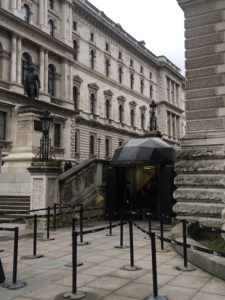
Following a very full day in Paris, we allowed ourselves to sleep in a bit. But only a bit, as we still had things we wanted to see (as if I needed to remind anyone of that). We elected to spend our morning at the Churchill War Rooms and Churchill Museum (an Imperial War Museum). This came highly recommended by my cousin Ava, although I must admit that as we made our way to the museum, it felt more like we were taking our required dose of bitter medicine in the form of a history field trip. (I could hear someone’s parent scolding their child, “You gotta know your history!”) While I much agree with knowing history, of course, sometimes history museums can be a bit, well, drab (like the Fusilier Museum at the Tower of London that we visited two days previously). However, the Churchill War Rooms were anything but drab, and I highly recommend a visit! We originally thought we could zip through the whole thing in about 90 minutes, but we ended up spending two-and-a-half hours at the place. And (dare I do it?) I gladly award the Churchill War Rooms that coveted rating of five stars out of five. It really is that good. Like the Tower of London and St. Paul’s Cathedral, I could go to the War Rooms again and again and again and never tire of visiting. Indeed, even the two-and-a-half hours we spent at the museum felt rushed, and I wished we could’ve had more time to explore (but Westminster Abbey was awaiting us in the afternoon).
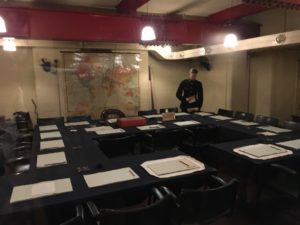
Upon entering the War Rooms, the first room we got to see was the room that frequently appears in film dramatizations: the War Cabinet Room, a large square-shaped room with tables arranged in–naturally–a square, seats enough for 21 people (I think), Churchill’s wooden chair at the head of the tables in the center behind a map, cigarette trays dotted about (I can’t imagine how smokey it must’ve gotten in these rooms). This room (along with the Map Room, Transatlantic Telephone Room, Churchill’s bedroom, and others) was left undisturbed when the lights were turned off on August 16, 1945, as early on people saw the historical significance of this space, so visitors get to see exactly how this room would’ve looked in 1945. Following the Cabinet Room, a hallway took us to the Transatlantic Telephone Room, the room where Churchill would’ve had conversations with President Roosevelt, a room with space enough for a desk and a shelf and a scrambling phone (codenamed “Sigsaly”).
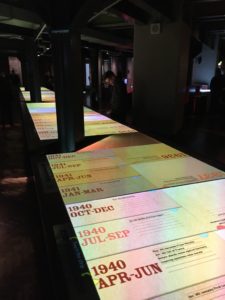
After a small exhibit (featuring blown up photos of women operating telephones in the rooms and Churchill looking forlorn as he surveyed a bombed London; artifacts including a noiseless typewriter that Churchill insisted everyone use as he hated noise and a chemical toilet that would’ve been used since the nearest flushing toilet was two stories above; and various plaques that described what life was like in the rooms, including a small paragraph about Smoky, a fluffy Persian cat who belonged to the kitchen staff and who Churchill adored and allowed to sleep on his bed), the Churchill Museum came next. This was the section of our visit that I thought we would’ve rushed through, but the museum was so engaging and so expertly prepared that it was actually quite difficult to leave. The museum was broken up into five sections (in this order): 1940-45 when he served his first term as prime minister; 1945-65 when he was defeated in the 1945 election, published his six-volume history of The Second World War, dubbed the rise of Communism as an “iron curtain” descending Europe, was re-elected prime minister in 1951; 1874-1900 when he was packed off to boarding school, became a cavalry officer and later a journalist for the Morning Post, was elected for the first time to public office in 1900; then 1900-1929 when he switched from Conservative to Liberal and helped create Labour Exchanges to help people find work, served as Minister of Munitions and then Secretary of State for War and Air, returned to the Conservative party in 1924; and lastly 1929-1939 when he was in political exile as a backbench MP, supported Edward VIII during the turmoil of the abdication, opposed India’s independence. We learned so much about the man in such a short span of time, all the while viewing artifacts from his life: a maroon siren suit (designed to be worn in air raid shelters), a grey RAF greatcoat, a 9mm submachine gun, a mould of his face for Madame Tussaud’s, his Nobel Prize for literature, the original oak door to 10 Downing Street, his famous Homburg hat and bow tie, and so much more. Even some of Churchill’s original paintings were on display, but I had irritatingly missed these entirely by accident.
Following the museum and a quick lunch at the cafe in the War Rooms, we finished touring the rest of rooms, but it all felt so rushed on account of having to get to Westminster Abbey in time before it closed at 3:30. Regardless, we still got to see so much in our visit to these rooms. But, next time I want to return and allow more time to really take everything in: the BBC Broadcasting Room; the Map Room; the Chiefs of Staff meeting room; Churchill’s bedroom and the bedrooms of so many other important people like Churchill’s wife and his various advisers; and so much more. As I said, it was so informative, so well curated, and just such an engaging visit overall. The guidebook wasn’t a disappointing purchase nor was the audio guide unwelcome. The whole experience was just incredible. Do go!
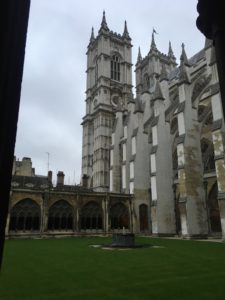
We had to make our way to Westminster Abbey next, as it closed for visitors at 3:30. We arrived at about 2:00 (it’s only a short walk between the War Rooms and the Abbey) and I was terribly worried that we wouldn’t have enough time to fully see everything, but I was surprised to discover that 90 minutes really actually is plenty of time to see everything there is to see at the abbey. Unlike St Paul’s where you get to visit the main floor, climb all those stairs to the galleries, climb all the way down those stairs to the crypt, visitors at Westminster all stay on the main floor. Despite this, however, there still is so much to see.
What always strikes me about Westminster is how cluttered the whole place is. (I wish I could share a photo with you, but there’s no photography on the inside of the abbey.) But this place really is jam packed with statues and monuments and tombs and vaults in every nook and cranny. If there’s space for it, there will be a tomb. But what tombs! An especially striking moment is when you enter the Lady Chapel and visit the tombs of Elizabeth I and Mary I, two sisters who hated each other in life but who are buried side by side forever in death. There are 30 other kings and queens buried in the abbey, including Edward the Confessor, Edward VI, and Queen Anne. The floor is equally overcrowded with graves. As you enter, for example, you’ll just happen to walk over the grave of Ralph Vaughn Williams and Henry Purcell, among others. Poet’s Corner in the South Transept is another sobering moment where individuals from C.S. Lewis to Charles Dickens to George Handel are interred within the floor. Also, make sure not to miss the nave where you can find the grave of Stephen Hawking who is buried appropriately next to Isaac Newton.
Westminster is also just such an architectural marvel. The bulk of the structure was built from the 13th to 16th centuries in that classic gothic style, and everything is just so ornate and so opulent. As the abbey’s website describes: “The architect [Henry of Reyns] was greatly influenced by the new cathedrals at Reims, Amiens, and Chartres, borrowing the ideas of an apse with radiating chapels and using the characteristic Gothic features of pointed arches, ribbed vaulting, rose windows, and flying buttresses.” Indeed, all of that is on display, and the radiating chapels filled with tombs of kings and queens is where this cluttered feeling really sets in. The whole abbey isn’t cluttered, of course; the quire is a wide open space where that iconic black-and-white chessboard tile is on full display, three rows of elegant wooden stalls on the north and south walls run the length of the quire from east to west, red lamps spaced evenly amongst the stalls like rows of soldiers.
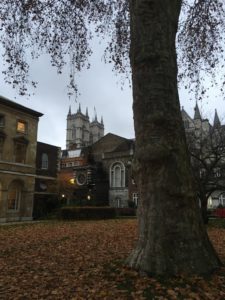
In addition to the inside of Westminster, there are other areas to explore as well: the Cloister Garth, a large outdoor green space with a solitary and unassuming fountain commemorating Lancelot Capability Brown, a famous landscape gardener and architect who died in 1783; the Pyx Chamber, an old stone vaulted room, one of the oldest parts of the abbey, entered via heavy oak doors dating from the 14th century; the Chapter House, a tall octagonal space with an elaborate vaulted ceiling and an impressive central column, elaborate stained glass windows on most of the eight walls, wall paintings dating from the 14th century depicting events from Revelations; the College Garden and Little Abbey Garden, stately green spaces that have been cultivated continuously for 900 years (only open to the public on Tuesdays, Wednesdays, and Thursdays, so plan accordingly). And, on your way out of the abbey, don’t forget to marvel at the Coronation Chair, which has been used at the coronations of all the English monarchs since 1308.
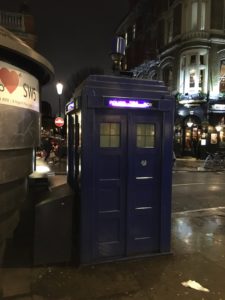
We had just a bit of time to grab a quick tea at a Caffe Nero (getting caught in a small rainstorm en route) before we wanted to return back to Westminster Abbey for Evensong, which happens every day (except Wednesdays, for some reason) at 5:00pm. As we were making our way back to the abbey, we were actually quite interested in the event, looking forward to whatever gorgeous music the choir and organist would perform. After Evensong was over, however, we all felt a little bit underwhelmed, I must admit. We were all surprised how much talking there actually was and how much the whole show, er, “service” felt like a, well, service. The audience, er, “congregation” was invited to do that thing where they recite those long recitations, er, “prayers” (that one about, “Our Father, who art in heaven,” and all that, and later on that other one about, “I believe in God the Father almighty,” and so forth). Meanwhile, listening to the music, I became hyper aware of how boring the psalms are and how difficult it is to set the bible’s text to music: composer Ivor Atkins’s setting of Psalm 72 was all very syllabic, and he had to set real clunkers like, “[h]is enemies shall lick the dust,” and, “There shall be an [sic] heap of corn in the earth.” (I must admit, I had to suppress some laughter with all my will.) Generally speaking, Evensong was just all really very underwhelming. I’ll probably never attend another service ever again. (It was somewhat fascinating and different listening to how much they pray to the Queen, though.)
And so, with that, we made our way back to South Kensington to our flat to begin our penultimate night in London. Before we retired for the night, however, we stopped by a Waitrose so I could stock up on these fantastic biscuits they have here that are generously coated in chocolate; visited an Odd Bins so Amy and Aaron could purchase a fine bottle of gin (they really love their gin over here); and then made a quick stop outside Earl’s Court station to admire one of the few police boxes still standing in England. Heading to bed on this night, I began to feel that pain of having to leave London behind again. But not before one last final fantastic day in what I still do believe is the greatest city in the world.
